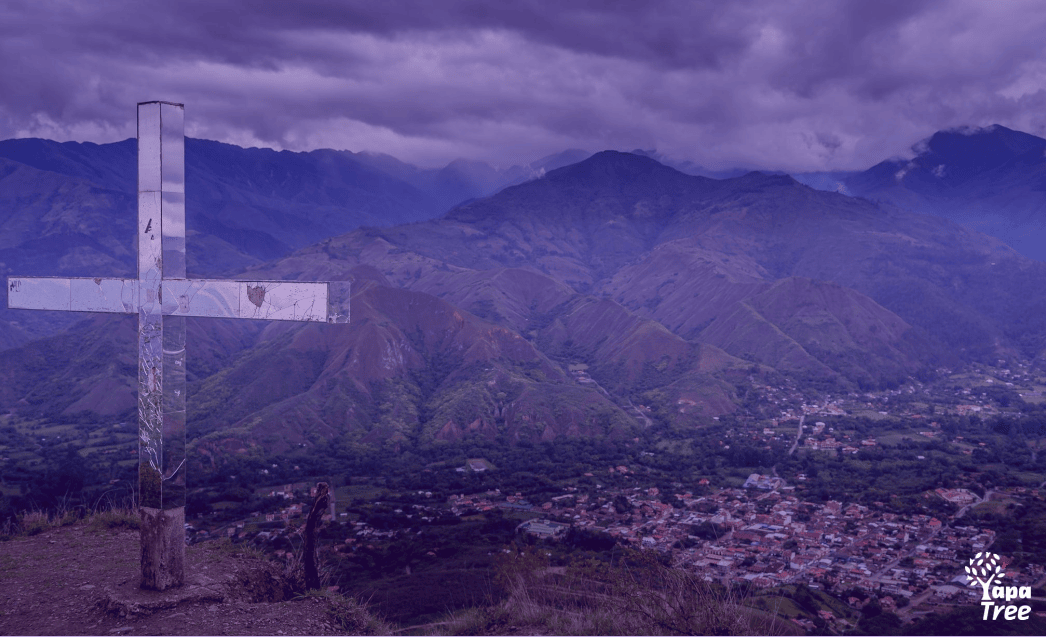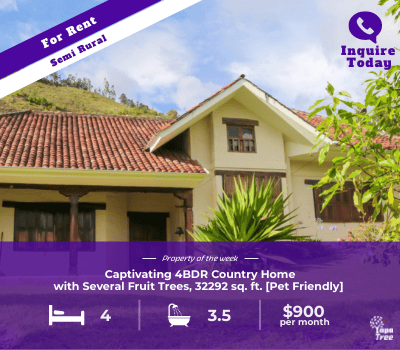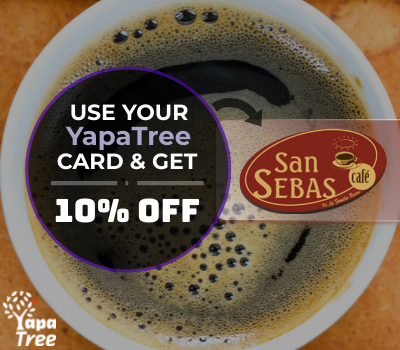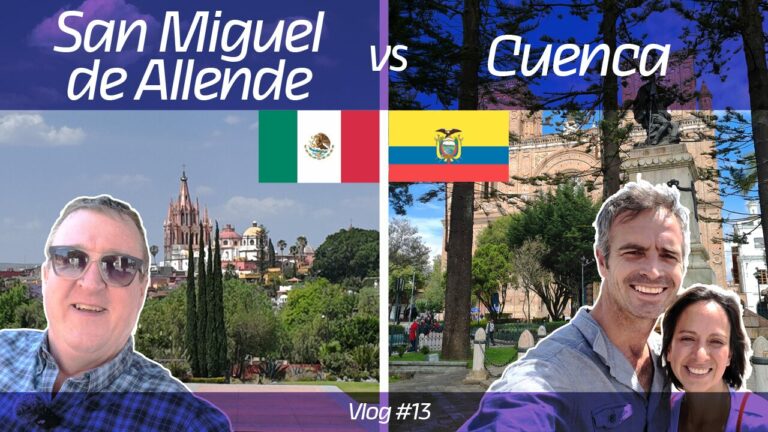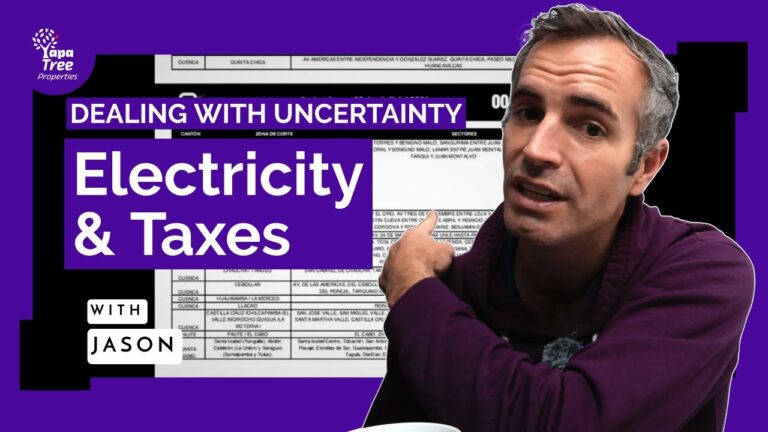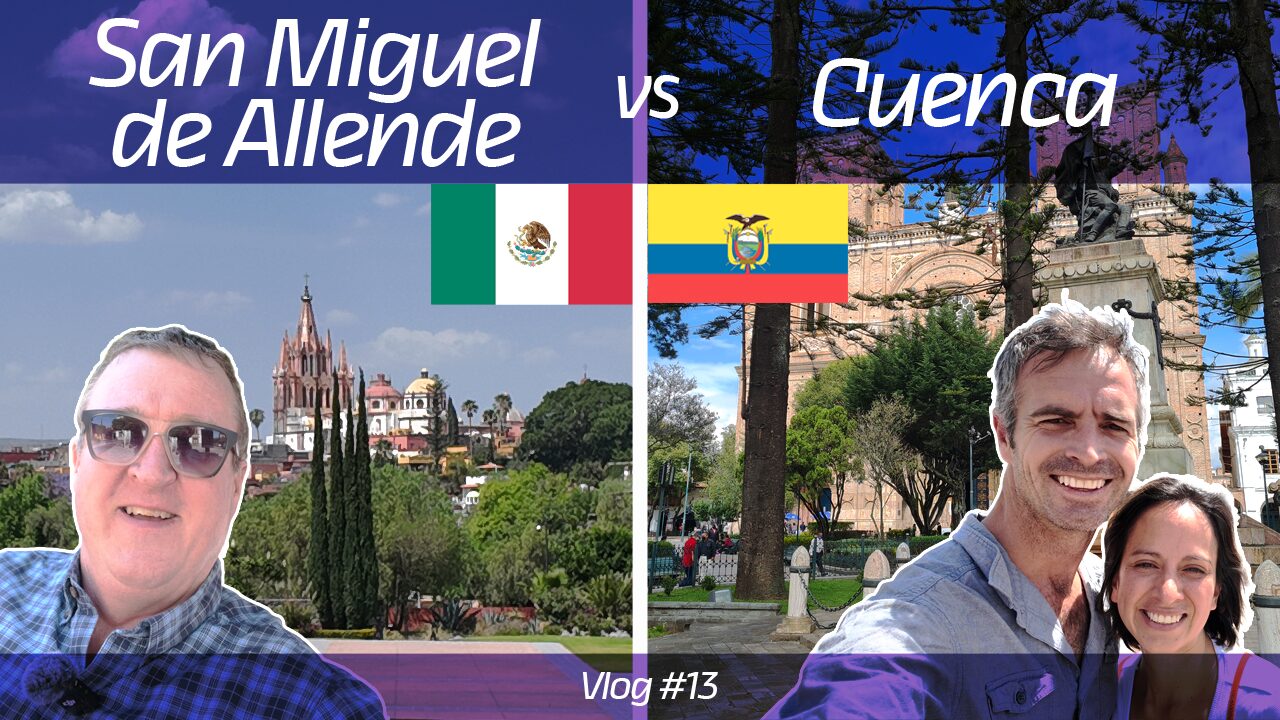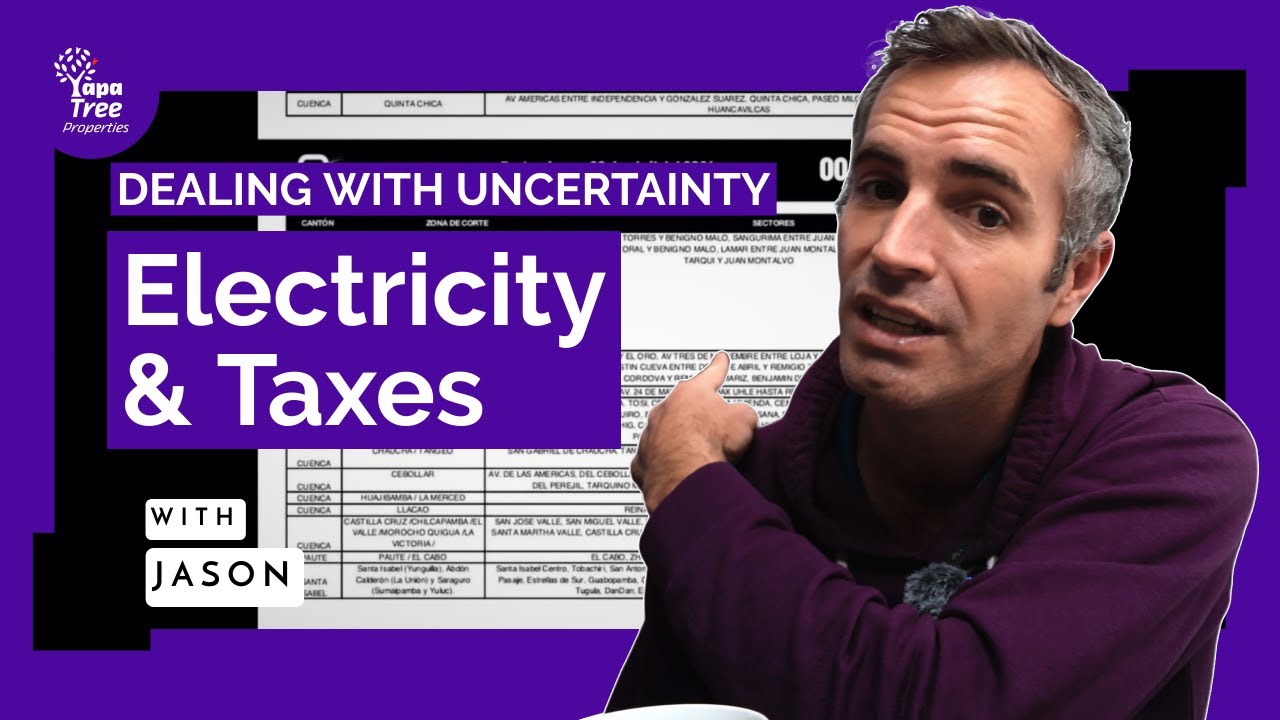Letter from Vilcabamba # 1
Editor’s Note
This is the 1st contribution by Vilcabamba resident, Annie Eagleton. Annie is producing a series of Vilcabamba-based articles titled ‘Letters from Vilcabamba’. We love the diversity that Vilcabamba offers and given that many of our readers also like to enjoy this area, we wanted to share it with you.
Firstly, let me introduce myself, I´m a Brit. Or more accurately, a world traveler who grew up in England, and somehow, by synchronicity or serendipity or fate, landed in Vilcabamba. For me, coming to South America had been a dream of 40 years and I spent a year learning Spanish in 1978 to help prepare.
After many meanderings, I decided to visit Ecuador in 2014 because a trusted English teacher friend recommended Loja as a good place to teach English. I´d been teaching in England and other countries for seven years.
Well, Loja did not inspire me. Nor did I find work there. However, the Colombian woman with whom I was couch-surfing, introduced me to El Paraíso – a wonderful spa and hostería just outside Vilcabamba.
After visiting the hosteria we enjoyed a stroll into the quiet ambiance of the village, complete with a visit to the French Bakery, La Baguette (there are now two French bakeries in Vilca). This was all the convincing it took for me to plan my return.
Two weeks later, I found myself on the top of Sacapo mountain, spending a very tranquil New Year with a Korean host. I was completely taken aback by her invitation to build a house up there. I wasn´t thinking of settling anywhere at that juncture, but the seed was planted. Wanting to learn about eco-building, I volunteered on a permaculture farm and went off on a completely different trajectory from my “plan“. Almost eight years later, I am still here!
This kind of thing happens to many people. It happens enough that some nickname it “Velcrobamba” – even though it is also known to spit some people out!
So what is it about Vilcabamba that draws people here? As expected, you’ll find expats from North America but also from lesser expected countries such as South Africa and Vietnam.
This article digs into some of the many reasons that expats find themselves living in Vilcabamba. We’ve talked to over 20 residents of Vilcabamba and have shared their reasons for living in Vilcabamba with you. Your experience will likely be very different, and that’s part of the beauty of living in Vilcabamba – celebrating each other’s differences.
Vilcabamba’s Origin Story
The village has a certain mystique with history dating back at least to the Incas, who purportedly came here to rest from battle. The Vilcabamba name has Kichwa roots, willka – “sacred”, and the name of the huilco tree (Anadenanthera colubrina) and pampa – “valley“.
The huilco tree, also known as vilca, wilco or cebil, is considered sacred for the psychotropic properties of its seeds which are inhaled as rapé (snuff) or smoked. I recently learned that the tree was not native to here, but seeds were brought from northern Chile in 800AD by mule train.
“The Valley of Longevity”
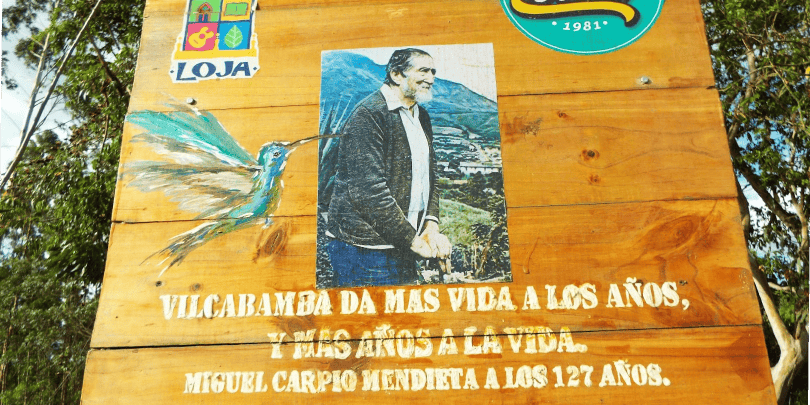
Vilcabamba has been acclaimed for its clement climate, stunning Andean landscape, fresh mountain air, pure water from Podocarpus National park and an abundance of fresh, local food. I can vouch for all of the above, though the rivers may no longer be so pure downstream.
A thriving Organic Market is a major attraction here on Saturday mornings, and the village boasts no less than three organic shops. The area is also known for the legendary longevity of its inhabitants, after Harvard professor Alexander Leaf reported on it in a National Geographic article in 1973 (purchase original article).
Indeed, I have met several locals in their 90s and heard tell of parents and grandparents who lived to well over a hundred years.
A Dutch friend, Renata, came here specifically after discovering it was a so-called ¨Blue Zone¨, though I could find nothing to corroborate that status.
However inaccurate or exaggerated some ages may be, what matters more is lucidity, health and happiness into old age. An interesting fact: there is no osteoporosis here, to this day. Perhaps the prospect of longevity is one of the factors attracting many retirees from north America to the region. But that´s only part of the story. The reasons people come here are as diverse as the backgrounds they hail from.
The “Early Expats”
Foreign migration here began with north American fruitarian, Johnny Lovewisdom in the 1960s, who long since passed on. Then came a young American couple, Joy and Curtis who have been major contributors to the local community through reforestation projects and other initiatives, including their exquisite artesanal beer, “Sol del Venado“.
1975: Martha & Glen, US
In 1975, another young American couple, Martha and Glen, arrived here from Colombia. They were the first I interviewed to answer the question, “Why did you come here?” Woven into their long, intriguing story were some very basic reasons: “We came for the place”, said Glen, a composer and musician, “we are fascinated by the place.” Live a simple life, sunshine every day, people are nice, you can live without a car. In fact, back then, there were no cars, no road, no cement and no electricity. People were full of awe regarding newcomers. “It was hard for the locals to believe that anyone would want to live here, as there was nothing!” There was no property; no one owned land (until Agrarian Reform). He added, “People are not in a hurry. If you want things done fast, don´t come here!“
Things have obviously changed dramatically since then. Several waves of foreigners have arrived in the ensuing years.
1986: Orlando & Alicia Falco, Argentina
Orlando and Alicia Falco, are Argentinian biologists and conservationists, who had both done research in the Galapagos Islands. It was fresh water that brought Orlando to Vilcabamba in 1986, as there was only brackish water on the islands in those days. He was looking for a quiet place to build a house and bought a hectare of land by a mountain and river. Some years later, 1998/9 with other people, they created the Rumi Wilco Reserve, a fabulous place to visit or stay.
2001: Daniel Pugh, UK/Canada
Daniel Pugh, a British-Canadian of Indian origin, has worked for Doctors Without Borders and other NGOs in numerous countries. He arrived from Afghanistan in 2001 “by happenstance”, found the place had a “resonance”, and a lady offered to sell him the land he was sitting on at that moment. He did buy it, though he did not come to live here permanently until 2020. The land is on the flanks of Apo Mandango, the male mountain spirit that presides over Vilcabamba. In 2012, he built the Pyramid – a natural structure of bamboo and sugar cane thatch, as a ceremonial space.
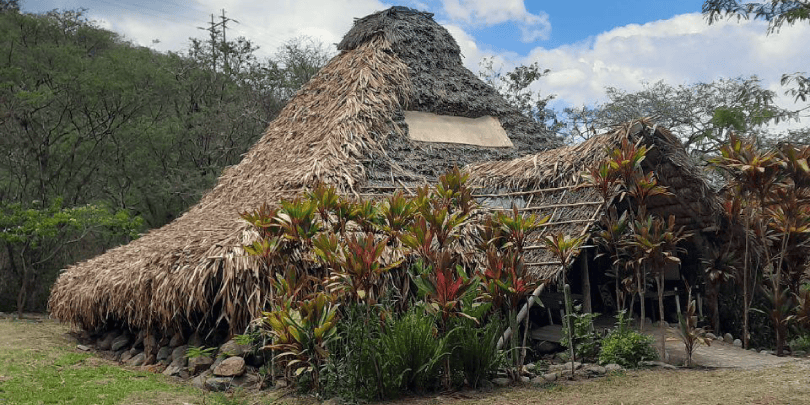
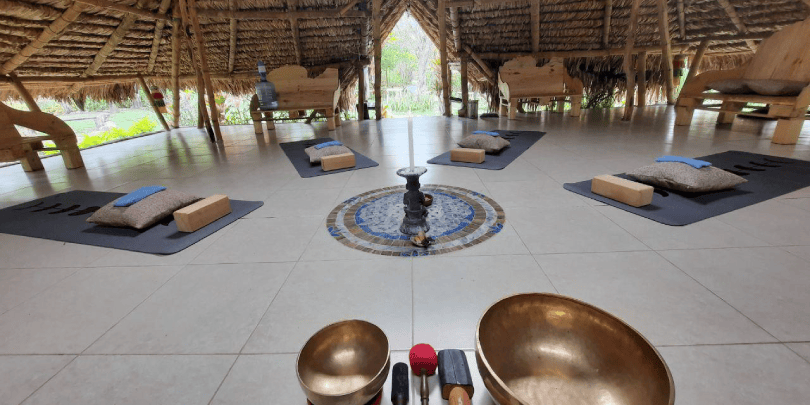
Daniel, a Conscious Movement teacher and cranio-sacral therapist, explains that the Pyramid concentrates the energy, “It´s for transformational practices: yoga, qigong, meditation, plant medicine, women´s circles and celebration of the Equinoxes and the Solstices…¨ Check out his YouTube channel & Facebook for more information.
2004: Dave & Mick Smith, UK
British brothers, Dave and Mick Smith came here one after the other in 2004, “after learning, of course, it’s in a vortex and the climate was great!” In those days there were perhaps only a dozen or so foreigners. Now that number has increased to a fluctuating 1000, among a local population of 5000 – 7000.
2010: Chandrika & Gopal, Kazakhstan
Chandrika and Gopal and their small family arrived from Kazakhstan in the winter of 2010 in search of fruit! Vilcabamba is abundant in fresh fruit, much of it locally grown. They had recently become devotees of Krishna and completely changed their lifestyle, becoming fruitarians. There was no fruit during winter in their previous home in Almaty, Kazakhstan, so a friend pointed them towards Ecuador.
After being initiated in Quito, they found the Hare Krishna Temple in Cuenca. Soon after, they discovered Vilcabamba and were invited to make the food for the Water Woman Festival (which incidentally also drew my wood carver ex-husband and son, Shane and Koa here before me.) This beautiful family is beloved for their delicious vegan food at Saturday´s Organic Market, and other events.
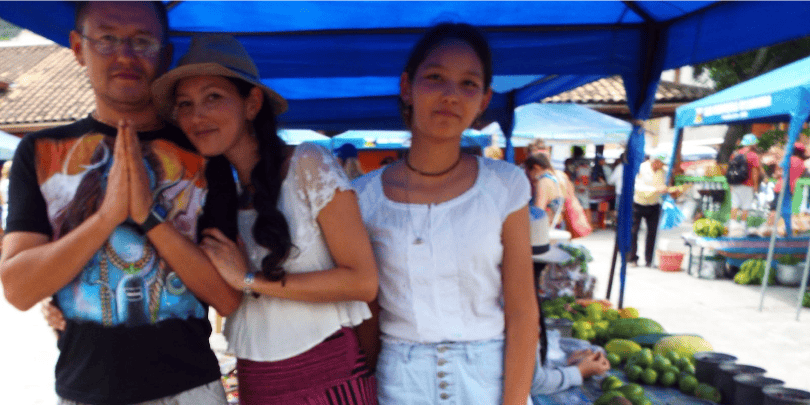
2011: Becca Tzigany & James
Some claim they were “called here”, as was the case with Becca Tzigany and her partner, James, in 2011. They were living in Mexico, when he suddenly heard Ecuador calling them, out of the blue. In Quito, the Consul asked, “Who called you? Are you spiritual people?”
“Yes!” they told her. “We are artists and spirits guide us.“ Author-poet Becca, fully bilingual, has become a mainstay of the community, founder of Ecstatic Dance here, Transformational Breathwork facilitator, mediator and ceremonialist.
2012: Jones Family, US
The Jones family arrived in 2012 from North Carolina after researching for seven years. Sharon is a Doctor of Naturopathy, whose vision was to open a healing center, but they were victims of a land scam and lost all their money. Being avid cooks, in 2017 she and husband, Will, began serving pot pies and opened their restaurant, Casa de Jones, in 2020.
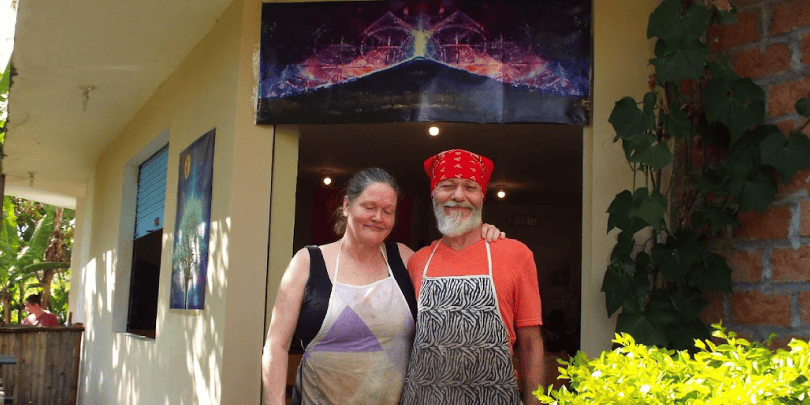
Variety of Food in Vilcabamba
When Martha and Glen arrived in 1975, there were only a few local restaurants. There are still several of those, economical, tasty options, and more seem to be opening all the time.
Nowadays, a plethora of foreign-owned eateries prevail with a choice of:
- Mexican (Mexibamba, Natural Yogurt and El Mexicano)
- Turkish-Arabic (UFO)
- American (Charlito´s, Casa de Jones)
- Italian (La Casetta and Mama Silvia´s)
- Indian
- Palestinian
- Taiwanese Noodles and Dumpling
- Fresh, organic trout (Shanta´s), and
- Another sushi restaurant opening shortly
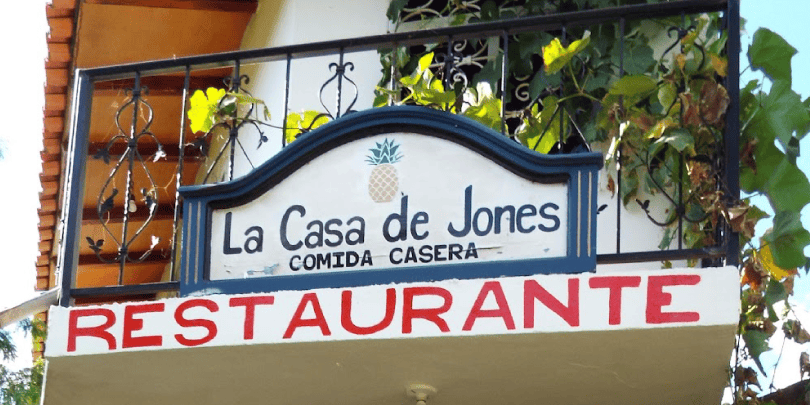
Not to forget Vilcabamba Gardens and Carro Azul, both of which have diverse menus and live music. An incredible choice in such a small town – if you have the money!
2013 Zia & Roshni, US
In 2013, Zia and Roshni arrived from Colorado. Zia is a Permaculture teacher and holistic body therapist. Roshni is a Waldorf Kindergarten teacher, movement education specialist and Biodynamic farmer. They came because they were very inspired by Ecuador´s Constitution and the Rights of Nature, and that GMOs were illegal here. Also because there is a strong indigenous population, “our values are very aligned with indigenous values … which are the most valuable ideologies that can help us reclaim the health of the planet.”
They opened up about their reasons for calling Vilcabamba home, “We heard about Vilcabamba, and almost didn´t come, because so many gringos is not our style! But Roshni knew Walter Moora, a very experienced Biodynamic farmer from New Zealand, so we came to visit him. Just seeing how locals and ‘transplants’ interact with ease and mutual respect. We bought land after 3 days!
Ten years later, I am concerned about preservation of the local culture and knowledge.”
Zia is indefatigable in her efforts to bring locals and foreigners together in community initiatives, especially in reforesting the valley.
Their farm, Vida Verde, is a Permaculture Demonstration garden, offering annual courses in Permaculture Design. Their courses are just one more reason people come to Vilcabamba, from near and far. This is also the first place I volunteered when I arrived in 2015.
2016: Younes, Algeria
Younes, 36, is an extremely talented and versatile musician, dancer, performer from Algeria, who speaks Arabic, French, Korean, Spanish and English. He was in Canoa, feeling very weak and tired, and met an army veteran from Afghanistan, who said he should go to Vilcabamba and he´d “find answers” there. When he arrived, in January 2016, after a grueling 48 hour journey, he was very disappointed to see all these foreigners!
Interestingly, he met a Korean artist in the park, and stayed at her place in Sacapo, the very same where I had sojourned a year before. He decided to stay because he found an “awesome community with stories of going all around the world, and there is this diversity of experience and nationalities that is very nourishing for me. And at the same time, you are surrounded by beautiful nature that encourages the introspection work.¨
However, he doesn´t like the economic imbalance between the local and foreign community, “The locals don´t have the same economic power, and that´s the source of criminality, of jealousy, of anger, of racism and resentment. I don´t feel very comfortable about this. The price of the land, the price of the goods, it´s like a small inflationalist bubble that is not convenient for the locals.”
I feel exactly the same.
2020: Susana & Santiago, Peru & Mexico
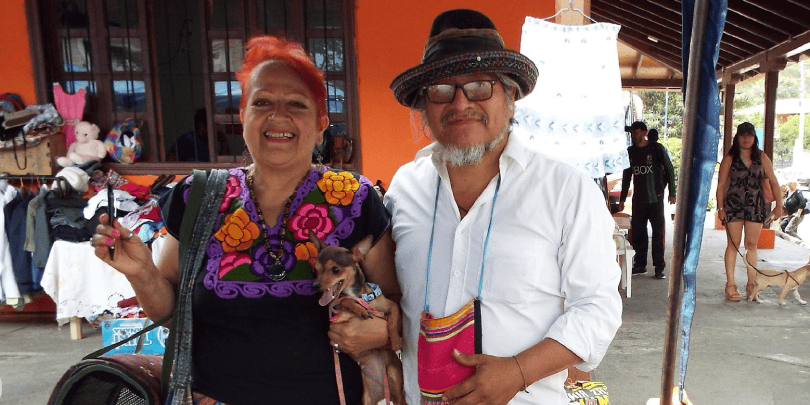
Many Latinos have also migrated here, from Argentina, Brazil, Chile, Peru, Mexico, and Venezuela. They often form a bridge between locals and other foreigners. In 2020, Peruvian, Santiago and Mexican, Susana moved to Vilcabamba after living in Loja for 4 years. Why? “Por la belleza, la naturaleza y el rio, que nos recuerdan a nuestras patrias.” (“For the beauty, the nature, the river, which remind us of our homelands.”)
Collaborating in theater and giant puppetry, Santiago, (Taita Illapa Inca) is a Wisdom Keeper of 1000 year old Andean Dance and ceremony. Susana is a singer and voice teacher. They also sell delicious home-made foods at the Organic Market.
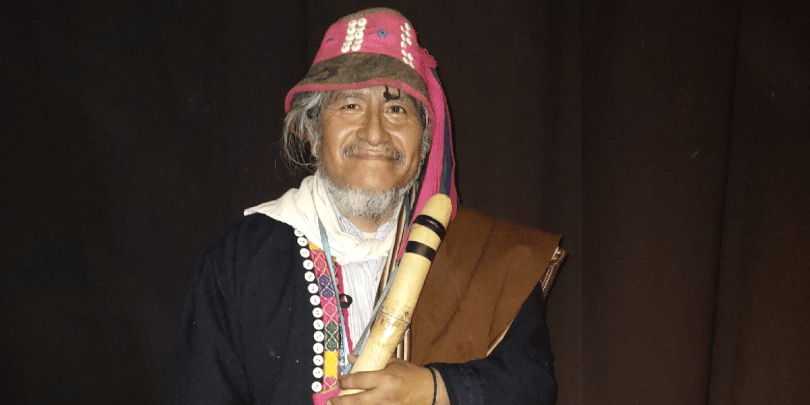
Vilca’s Music & Noise
There are a number of talented resident musicians of every ilk. From Latin to classical, traveling minstrels, as well as visits from the Loja Symphony.
However, fiesta music can be unbearably loud, and those of us living in the hills get the amphitheater effect, sometimes into the wee hours. Vilcabambeños love their fiestas and they love LOUD!
Other annoying noises can include barking dogs – every house around this farm has 1-5 dogs, crowing roosters from the many fighting cocks, and motor bikes without mufflers.
Seeking Healing
People come here, of course for healing, and Vilcabamba has attracted its share of therapists and healers. Myself included as I’m a practitioner of Shiatsu and Thai Massage.
Last year, Margarita, half American, half Ecuadorian, and a multifaceted poet-dancer, was living in Quito when COVID hit. After being locked down for many months, she came to Vilcabamba on “doctor´s orders”. Though relatively young at 42, she has suffered from serious health problems, exacerbated by the altitude. He suggested living somewhere warm at a lower altitude (1595m / 5233ft).
A plant medicine retreat in Vilca was a major part of her healing, and as a Primal Dance facilitator, she found her community, and a sense of belonging like never before. She found great inspiration, “Poetry was coming out of me at 4am, as soon as I landed here! – Vilca shook the ground I was walking on!”
Since 2020, COVID regulations and mandatory vaccines have been a driving force behind some people moving to Vilcabamba.
Kathlyn arrived in 2021, providing her background for the move, “My entire reason for coming to Vilcabamba was that I was hoping to find a group of people on the same page about COVID vaccines as I was. The story is a bit dramatic, because of what it was like for me to ‘escape’ from the COVID tyranny of Cambodia…”
Lisa, a newly-arrived Canadian yoga teacher explains her plight, “In January 2022, particularly as a result of the Trucker Convoy experience in Ottawa, we started really feeling the need to leave Quebec and Canada based on the very repressive, illogical and unacceptable governing. We were prevented from working and participating in society due to our choice to trust our immune system vs getting injected with an experimental concoction.”
And there are many young travelers, like Alessandro, from Cyprus who came straight to Chambalabamba, an eco-community of young Latin families established in 2012 with a focus on music, dance, art and organic food.
Division of Locals & Expats
We are multicultural, yet in spite of many efforts over the years, to invite and include locals in foreign-initiated projects and endeavors, there remains a cultural divide. Vilcabamba people are family oriented, farmers and horse people. They stay close to family and to the land, often living from week to week on meager wages.
Foreigners come from all walks of life; including travelers, young, old, single, married, retired and from a diverse range of countries, beliefs & attitudes.
Locals are always friendly, respectful and polite, but I think they are still struggling to understand us. Particularly because we are not a homogeneous group. Understanding local culture & customs and interacting with the local community requires at least a basic command of Spanish. Unfortunately, many foreigners do not learn basic Spanish, which both hampens their ability to interact with locals and can exacerbate the cultural divide.
If you want to come here from the “developed” world, because the cost of living is cheaper (though Vilcabamba is more expensive because of foreign influx and tourism), and sit around drinking beer all day, well, you can. But you can do that anywhere. Living in such a bubble means you would miss out on so much local color and involvement.
Other Downsides to Vilcabamba
Here in the Andes, we have plenty of natural and human-made obstacles. Tremors, floods, rock falls, strong winds, steep hills & poor roads – these are all realities. Some places are lacking in basic infrastructure such as hot water & stable internect connections. Foreigners may sometimes complain of poor workmanship – but can you blame the workers when they are working for $2.50 an hour?
Vilcabamba also has its dark side. Increasing gentrification, injection of foreign money, and buying up of real estate (a concept unknown here 50 years ago), have all generated a notable income gap with the local population. This has led to the creation of a fertile ground for opportunists and thieves. Hence, there have been several waves of home robberies, some violent.
Due to the impotence of the local police, neighborhood security groups have been formed. Vilcabamba has also had a number of rapes, notoriously of women hiking the sacred mountain, Mandango. And yes, there have been murders. The aforementioned vortex draws the whole spectrum of people, from luminaries to low life.
Wrapping up
Vilcabamba is an extraordinary place which attracts extraordinary people with exceptional talent, creativity and vision! To date, I have counted some 50 nationalities, with as many languages – see my Vilcabamba Tree of Languages below. It is definitely a place where the Eagle and Condor fly together, as in the ancient Incan and Amazonian prophecy, here told by John Perkins:
If you are drawn to coming here, remember, it´s not just what Vilcabamba can do for you, but what you can do for Vilcabamba.
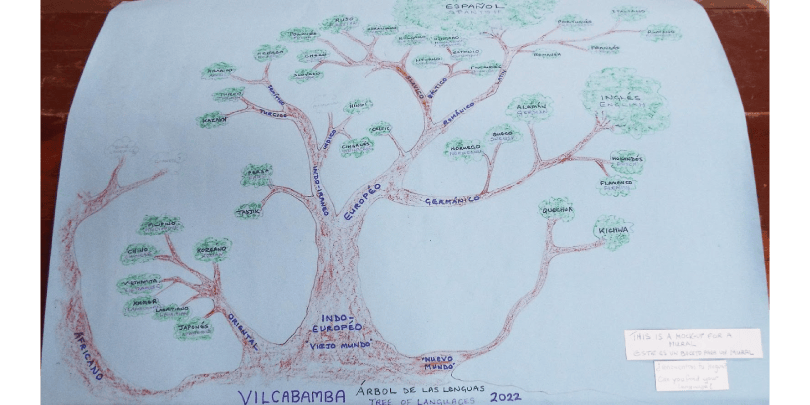
===
Want to know more about Annie Eagleton? Visit her blog today.
Feature image supplied by a brilliant photoger: https://travelinian.com/

